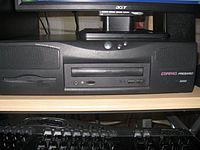Compaq Presario 2200
 |
|
| Developer | Compaq |
|---|---|
| Type | Desktop |
| Release date | 1997 |
| Discontinued | 1998 |
| Operating system | Windows 95 |
| CPU | 180 MHz Cyrix MediaGXi CPU; 66 MHz bus speed |
| Memory | 16–32 MB EDO DRAM; supports up to 80 MB; (2 MB of memory reserved for video card) |
| Storage | 1.6 GB Quantum Bigfoot HDD |
| Graphics |
Intel generic GPU VGA connector |
| Input | PS/2 keyboard and mouse |
| Connectivity | Dial-up modem upgradable to 56K; 33.6K modem standard |
| Power | Steady-state 51 watts |
| Dimensions | 4.0 in (10 cm) × 14.17 in (36.0 cm) × 14.5 in (37 cm) |
| Weight | 19.8 lb (9.0 kg) |
Intel generic GPU
The Compaq Presario 2200 is a small form factor desktop PC produced by Compaq from 1997 to 1998. It was produced as a slim, small form factor machine mainly intended for budget-minded consumers. When launched, it had 16 MB of EDO DRAM that was expandable up to 80 MB and a Cyrix MediaGXi microprocessor, clocking at 180 MHz. It did not include an Ethernet port; however, the modem can be swapped out for a compatible 8-bit ISA Ethernet card to allow the computer to be connected to the Internet or a LAN network. There are no USB ports on the computer, even though the small metal flap might suggest that Compaq considered installing USB ports during the time the computer was developed. This computer model is not to be confused with the newer Compaq Presario 2200 laptop computer.
The Presario 2200 originally shipped with 16 MB of EDO DRAM built into the logic board with two 72-pin SIMM slots for expansion. The memory can be upgraded to 64 or 80 MB. More than 80 MB can be installed but the Presario will only recognize 80 MB of it.
The Presario 2200 comes with two PremierSound speakers, one of which has a bass-enhancement tube leading to the back of the computer that Compaq referred to as a "Phantom Subwoofer" feature.
The Presario 2200 is also a media computer, hence the ability to play an audio CD while the computer system is shut down.
The Compaq Presario 2200 originally shipped with a 1.6 GB Quantum Bigfoot hard disk drive. This hard disk uses an IDE interface and can easily be removed from its caddy that sits just above the CD-ROM drive. The user can upgrade the hard disk to a maximum of around 10-20 GB.
...
Wikipedia
